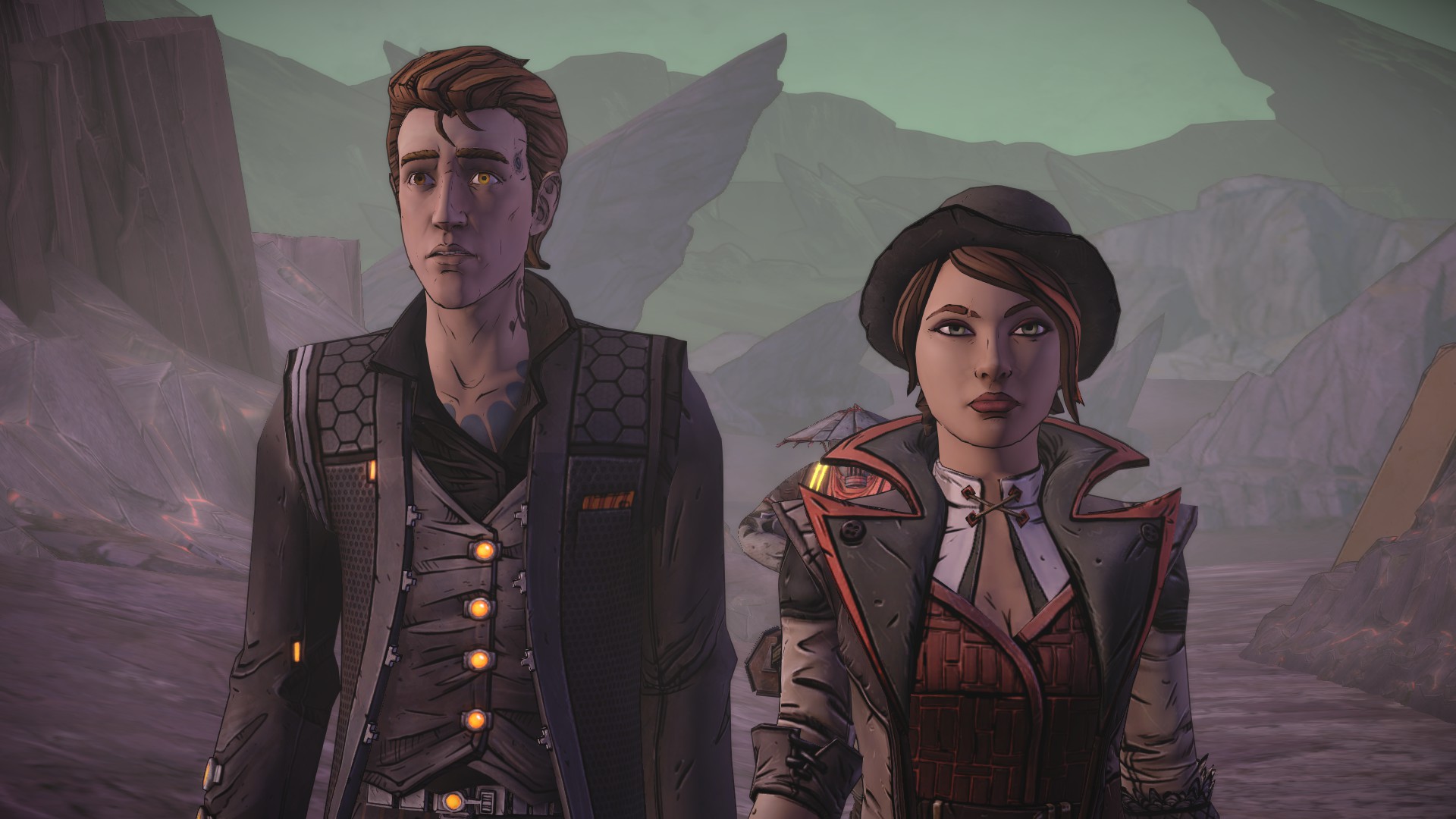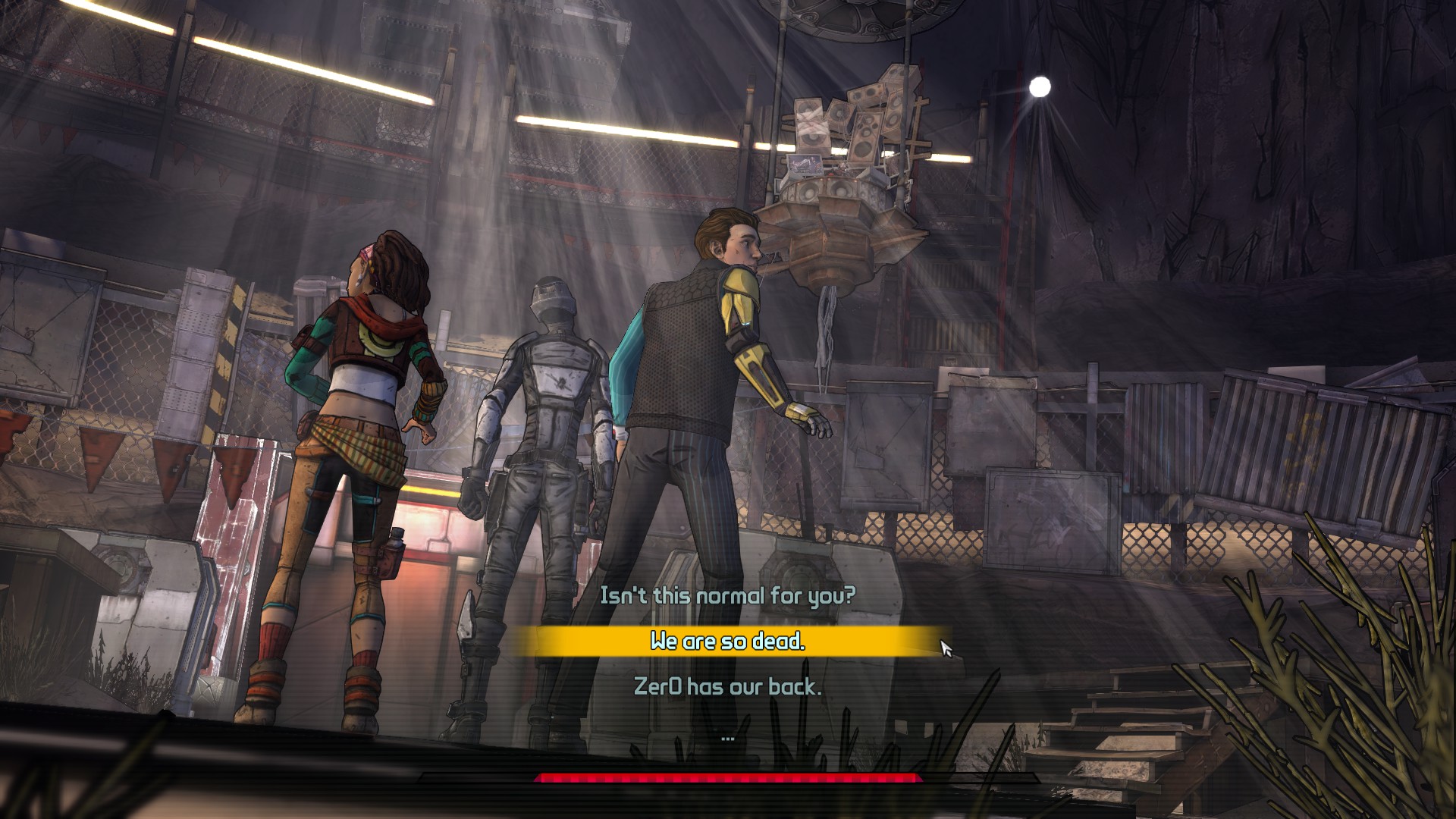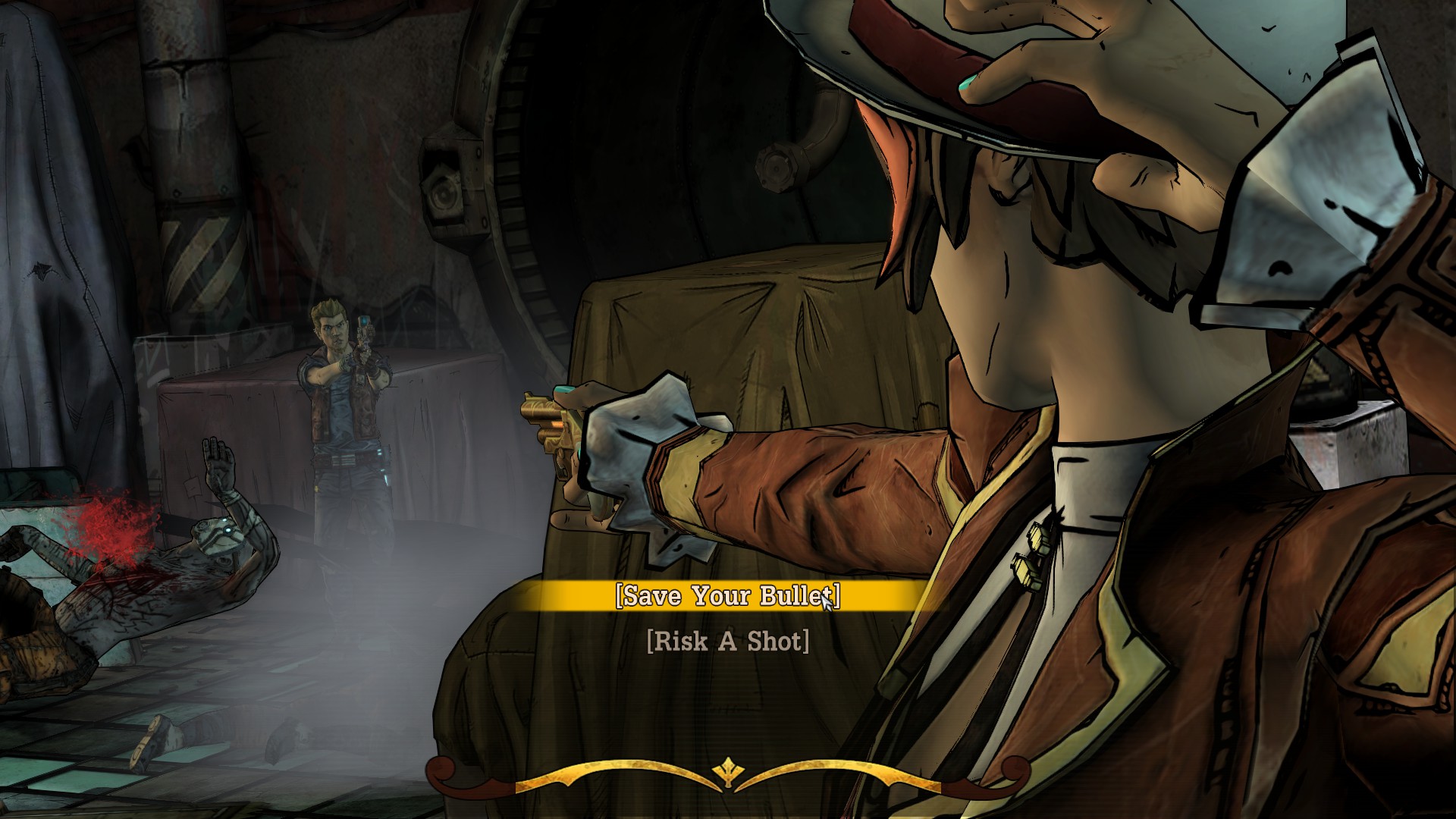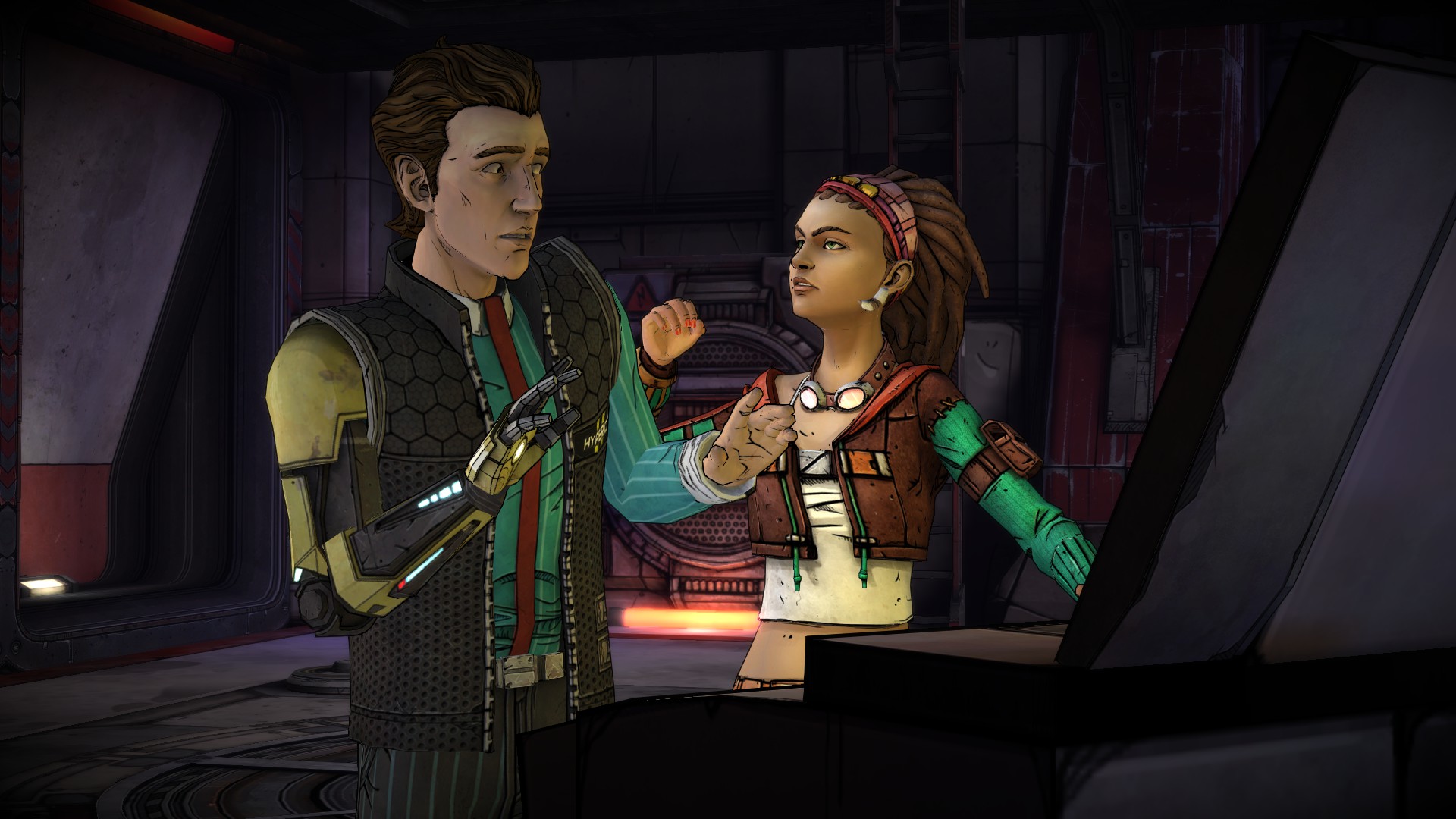When I first saw Tales from the Borderlands announced alongside Game of Thrones, I was puzzled. Sure, Game of Thrones makes sense as a Telltale game. Its universe is consistent with all their major licensed games since The Walking Dead. But Borderlands? Now there’s an outlier if ever I’ve seen one. It was such an anomaly that I had no idea how it would even work. The announcement trailer doesn’t even consider the question. It just throws a couple of unknown characters onto the screen and goes, “Yep, this is Borderlands. And yes, we know this is insane.” Shrugging in confusion, I filed the game away in my memory as an oddity, along with a brief footnote questioning the health of the studio.
Two years later, and I’m beside myself having just played through the most enjoyable Telltale adventure ever. Against all odds, I’ve even started it up again for a second playthrough! That’s how much I loved being a part of this world, that I’d even put up with the usual Telltale replay shenanigans in order to experience it again. But even here, Tales from the Borderlands excels against its brethren who are only too easily exposed as illusionists, because believe it or not, even on a replay, you’ll still end up making the same choices as before. That’s how captivating the scenario, setting and characters are. Even when given the option to “play” around and do something different, just to see what happens, I don’t. The few times in which I did think to deviate were usually in those situations where you have to make a choice based on incomplete information, which can be interesting the first time around, but since you become precognizant upon finishing the game, it can affect your decisions. But apart from that, my playthrough’s remained mostly consistent with the first.
Why is that such a big deal? Some time ago, I wrote that the definition for a great QTE is one in which you’d never even dream of failing. Not even once. My example was the first boss fight from Metal Gear Rising: Revengeance. To this day, I have never seen what failure looks like when you’re told to “stop that blade”. I stop it every single time. And I’ve played it many, many times. Sometimes I’ll start a run and think to myself, “Maybe I won’t stop it this time, just to see.” But once I’m in the middle of the fight, and the music kicks into overdrive with that massive blade swinging down overhead, I gotta dance. I stop that blade, powerless to do otherwise.
That’s videogame magic. It can happen when you’re playing as Raiden, the cyborg ninja, and it can happen when playing Tales from the Borderlands’ Rhys and Fiona. Oh yeah, there are multiple protagonists in this game. Now I know what you’re thinking. Given that almost no game has ever used multiple protagonists well, you’d be right to be skeptical. And to be honest, there really isn’t any good reason for it here except that they’re both such great characters, with their fair share of unforgettable moments each that to pull one of them out would cause irreparable damage to the game. Best to leave it as is then. Even if the narrative does have to occasionally pull some strings in order to justify splitting them up to give more satisfying variety between them. At least it tries to make up for this somewhat with its framed narrative, which lets the designers have some fun telling a story in a novel way and gives them more freedom to write exaggerated, one-off scenes for a good laugh.
Rhys plays just like any previous Telltale adventure hero, but with an Echo-Eye that allows him to scan the environment like in Metroid Prime either to analyze something for more information or to hack into it. Few things are hackable apart from what’s directly required to advance the plot, and the flavor text discovered while scanning everything else can be amusing, but there’s nothing more to it than that. Nothing you scan will ever be useful later on in a conversation, critical decision point or even help you understand the setting better, which seems like a major oversight. It’s as if it was included just to easily insert more jokes into the game. It wasn’t worth it to me (the game’s funny enough as is), so I rarely went out of my way to scan anything. Maybe Telltale knew that would be the natural response to the Echo-Eye, based on the hilarious moment from the first episode that had Fiona and her sister scrambling in a panic when they noticed Rhys had one. That scene perfectly demonstrated the incompetence of the Rhys character in a way that made me feel personally responsible for his failure via this uninspiring mechanic. That was pretty clever.
Instead of an Echo-Eye, Fiona has a brilliant little tool given by her adoptive father, Felix, at the beginning of the game — a single-fire sleeve gun. Use only in emergencies. But how do you know when it’s time to pull the trigger? That’s the fun part. When something dramatic happens that might call for a bullet, time slows down, a timer appears at the bottom of the screen, and you have to quickly decide whether or not this is the time to shoot. If you don’t take it, what will happen? But if you do, what happens then? And what if you miss? As you carry on, an interesting question emerges, “If I fire this gun, will I ever get another bullet?” It’s Pandora though, so unfortunately the bullets refill quicker than you’d think and become practically infinite near the end of the game via mandatory gun upgrades (although I did like the element upgrade). This makes it really convenient for the designers to write a scene without worrying if Fiona’s already fired her gun three episodes ago, but unfortunately made for a missed opportunity. The other Telltale-ism that prevents the gun from shining as brightly is the inability to draw whenever you want. But why can’t you? Even Telltale’s Sam and Max games let you pull a gun and fire whenever you wanted (although it had its problems too). Combine that with a single-fire gun with dubious reloading prospects, and you’ve got yourself a very interesting situation on your hands. And in a setting as dangerous as Pandora’s, it’ll make you think twice before pulling a gun without cause.
Fiona also has a wallet of cash, which can be used to buy various things and bribe people, although I never saw another bribe option after the first episode. Cash can be found in the usual Borderlands way, by exploring, making the game feel more like an adventure game than usual for Telltale lately. It also tries to do the same thing that the limited bullets do by presenting a choice that makes you think, “Should I spend this money now? Or should I try to save up for later?” It results in pretty much the same thing in the end, but unlike with the bullet, there’s really no appreciable effect from when you do spend money on something stupid. It’s fun to think about, and I like finding cash here and there, but too little is done with it.
You can see the ambition for where these mechanics were originally headed in Fiona’s first encounter with Tector, the bouncer. Both options are available via dialog choices, either to draw your gun at him, or to try bribing him. It’s a real shame that these interactions disappear from future conversations. Telltale had something to prove with this game, which is where I think this ambition comes from, but once they realized the story and characters were strong enough to stand on their own, they dropped it and hoped no one would notice. So now we’re back to where we started. Here’s hoping that wherever those ideas were coming from stays with the studio long enough for them to develop, not a Tales from the Borderlands: Season Two, but rather a sufficiently improved game worthy of the name Tales from the Borderlands 2.
For that, I would hope that they’d spend some serious time improving their engine. Although the graphics match up well against previous Borderlands games, nicely complementing Telltale’s experience with cel shading and resulting in their finest work yet, the animations are still the weak point. Whenever it’s just people standing around and talking, it’s not too bad apart from some obvious facial animation re-use. But once the action starts, some of the more dynamic character animations really fail to blend in well with the rest of the scene. It looks very stiff and amateurish, as if it was a small wonder that the engine could even handle these scenes at all, and the developers just called it a day at that. It reminds me of a developer commentary I saw for The Walking Dead’s second episode. It showed the scene where Lee and a friend were running through the woods during the intro, with the camera following them from a side view. I thought it looked awful for the same reasons as given above. Even laughable. But the dev in the video said that he was very proud of that scene for what they were able to accomplish with the engine. Sad to see that they’re still falling short, and I hope that before they release any more action-heavy games like this, they address this issue more seriously.
That being said, if you’ve ever found yourself wondering where all the games like LucasArts’ old adventures have gone, stop wondering and play this game right now. It recalls the very best of The Secret of Monkey Island and will have you laughing out loud just like in the old days. The secret formula seems to be a cast of likable characters who contrast well against a harsh, yet insane, world. It’s completely unpretentious and makes us realize that more important than the adventure itself is the people we’re spending it with. Occasionally, you’ll also see lone vault hunters running around the wasteland, to the dismay of everyone. They’re “worse than bandits” according to one of the characters. “You know how they are.” It’s fascinating, to say the least, to see life in Pandora from the perspective of normal people who can’t just go gun crazy on everything, and I couldn’t help but compare it to my experience with Gearbox’s other Borderlands games. Between the two, there’s no question that Tales from the Borderlands comes out on top, revealing not only the true strength of the adventure game genre, but also further reinforces the idea that playing a greedy, murder machine all the time is dumb.
Telltale’s even taken some of their biggest criticisms against their QTEs to heart. I nearly fell off the couch when I played this part from the first episode. There are plenty more scenes like this where you have to rapidly think to yourself, Do I do this, i.e. follow the button prompt, or don’t I? Although there was some element of my wanting to fail that QTE on purpose because I thought it’d be funny, since the setting allows for such humor in the first place (unlike in games like Heavy Rain) it becomes a valid branch, and we’re treated to an unexpected piece of videogame magic that we can laugh with, not at.
The humor, which is top notch and superbly acted, is a mix of late-night cartoons such as Archer and The Venture Bros., but without the raunchiness. There’s even a Dr. Venture look-alike in the character Vaughn, and Hugo Vasquez is voiced by the inimitable Patrick Warburton. The only problem with this style of humor is that some of the jokes are of the kind engineered to get 20-somethings yucking it up afterward at the office. I have a low tolerance for that kind of thing, where I can see past the joke to the writers trying to play me. Thankfully, the only character really guilty of this is Vaugh, and the rest of the cast are entirely hilarious in their own natural way.
I also loved the game’s use of licensed music for its episode openings, which reminded me of the glorious opening from Saint’s Row IV. These are all beautiful little moments that remind us that videogames can be wonderful things. Purged of all the sadism, despair, and grit from previous Telltale series, Tales from the Borderlands instead gives us what we’ve really been craving from the art — joy.
★★★★



